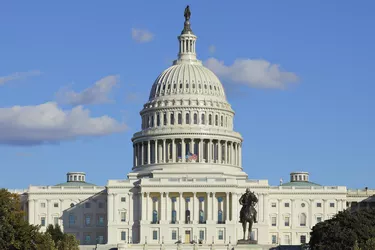
While you might hear about fiscal policies often, if you find yourself asking, "What are the goals of fiscal policy?" you're not alone. The term "fiscal policy" refers to the actions taken by governments to influence their country's (or state's or county's or municipality's) economic conditions, explains the International Monetary Fund (IMF). These include goals and objectives primarily based on government spending and tax policies.
As an investor, it's important to be aware of pending, expiring or existing fiscal policies to help predict how certain stocks you own might perform during the coming year. As a voter, you should watch fiscal policies to see how the overall economy might react. Understanding some of the common goals of fiscal policy will help you stay informed so you can make better saving, spending, investing and voting decisions.
Video of the Day
Video of the Day
Read More: Form 1040: What You Need to Know
Promoting Economic Stability
In a capitalist country, citizens often prefer that the government take a more hands-off approach to the economy and let markets and businesses guide things. However, due to external factors, such as weather-related crises, international problems or health issues (like the COVID-19 pandemic), governments often intervene to help stabilize economies.
For example, during the COVID-19 crisis when millions of people lost their jobs, the U.S. government offered citizens stimulus checks and expanded unemployment benefits. The government offered low-cost and forgivable loans to businesses to help them pay laid-off or furloughed workers.
Another way the U.S. government tries to create economic stability is through the U.S. Federal Reserve raising and lowering the prime lending interest rate. The Fed does this in response to unemployment and inflation to try and help prevent a strong economy from "overheating" or a weak economy from going into a recession.
Stimulating Economic Growth
Fiscal policy also aims to help spur economic growth. For example, when a government is taking in lots of taxes, it will budget some of the money to improve infrastructure, which makes it easier to make, transport and sell goods and services. In addition to helping businesses and consumers, this also makes the country more competitive with other nations, creating expanded demand for its products and services.
A country with high tax revenues might spend more on education so that employers are able to hire better-trained employees. This might include offering students grants or low-cost loans for college. Fiscal policy can include funding research and development that can be used by the business community.
For example, much of the technology used by Silicon Valley firms to make and run computers and phones was developed using research and technology funded by the military and NASA, then given to corporate America. NASA, for example, had to come up with ways to shrink computers to get them into space capsules. They funded research (using government funds) at universities and private businesses to do this. Private companies would not have been able to pay for this research and development by themselves.
Read More: Tax Credits: What Are They & How Do You Qualify?
Reversing Economic Decline
When economies enter downturns, such as recessions, fiscal policy aims to use government spending and taxation to reverse this decline. A recession is usually defined as two consecutive quarters of negative gross domestic product growth.
Gross domestic product is the total of a country's personal, business and military spending. Recessions result in higher unemployment rates, lower business sales and profits, increased government spending on entitlements (such as food stamps and unemployment payments) and decreased manufacturing.
Making money "cheaper" by reducing the prime rate allows businesses and consumers to borrow (via loans and credit cards), stimulating spending, which stimulates sales, taxes and jobs growth. Typically, fiscal policy goals focus on preventing recessions and continuing expansions.